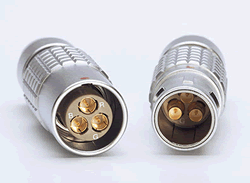Ambidextrous Connectors
You don’t always need to seek out a specialty medical connector. Many products that weren’t specifically designed for the medical realm can perform admirably in medical applications, while meeting the needed standards, and keeping costs low.
We take a look at ambidextrous products from LEMO and AVX to learn more about multi-use connectors. LEMO’s new 3GHz coaxial contact is designed for broadcast equipment, and provides high signal integrity in video applications. However, the company invited medical professionals to contribute to its creation, enabling it to perform to the stringent specifications required for use in surgical operating theaters. Similarly, AVX’s compression connectors for removable or pluggable modules meet high-reliability and harsh environment standards. This makes them a good choice for portable medical technology, even though they weren’t targeted to that market.
We spoke to Steven Lassen, Product & Applications Manager at LEMO, and Tom Anderson, Connector Product Manager at AVX Corporation, to learn what it takes to design a connector that can benefit applications across many industries, as well as perform in critical medical environments.
Connector Supplier: What medical products can use your multi-use connectors?

LEMO 3GHZ 75 Ohm contacts
Steven Lassen: Our new 3GHz connector can be used in legacy applications where 75Ω video is required, such as imaging and diagnostics, or in RF ablation applications where 50Ω or 75Ω impedance is required. Other applications include communicating with implantable medical devices (IMDs), RFID equipment, X-ray/teleradiology, and MRI machines. The new contact can handle a higher frequency of 3GHz, rather than 1.5GHz, which means more bandwidth for higher resolutions and additional spectrum for diagnostics.
Tom Anderson: Our battery connectors were initially designed for removable battery packs used in cellphones or portable, industrial handheld electronics. However, we designed them with higher-functioning materials rather than purely cost-driven selections, which provides critical long-term reliability and makes them ideal for use in portable medical equipment as well, especially when repetitive mating cycle are required, such as in patient monitoring or high-cycle disposable applications.
Connector Supplier: What new capabilities are these products bringing to medicine?
Steven Lassen: Video is being used in both invasive and non-invasive medical applications. The invasive cameras are getting smaller in size, and some may require an electrically shielded coaxial contact for transmitting video via wire. Non-invasive applications can wirelessly utilize RF signals, which are then received or transmitted via a wired connection.
Tom Anderson: Technology is allowing patients to have more daily control over their medical monitoring with wearable devices that can collect, store, and communicate critical medical data right from the comfort of their home.
Connector Supplier: What specific problems does this new connector solve?
Steven Lassen: This particular 75Ω contact was designed for the professional broadcast market, in order to combine several 3GHz video outputs — including HDTV, 4K, and 8K — into a single, compact connector with quick-disconnect capabilities and robust environmental sealing. However, the new contact design can also provide a 75Ω option for 50Ω RF ablation applications, and its quick-connect/disconnect housing enables easy mating and unmating, even by non-technical hands, and can also withstand sterilization processes, which is critical for many medical applications. In addition to single RF contacts, one of LEMO’s specialties is combining 75Ω or 50Ω coax with electrical and signal contacts.

AVX contacts
Tom Anderson: End-user survivability! These connectors are very robust, which is a foremost concern for medical professionals who need to be able to count on their equipment when they are working with patients. These modules feature gold-plated beryllium copper (BeCu) contacts, which will not relax or fatigue over time and are designed to absorb abuse.
Connector Supplier: What unique considerations are involved when designing connectors that could end up the medical market?
Steven Lassen: Risk is one of the more unique considerations in the medical market. Medical connector designs must take into consideration risk to both the patient and the operator, as the connectors in these applications are expected to perform flawlessly each and every time they’re used. As an ISO 9001:2015 and ISO 13485:2003 certified company, LEMO considers and appropriately addresses such risks when designing new connectors, and especially for this market.
Tom Anderson: I think history and experience are the key drivers. The heart of any connector is the contact system. So, starting with a proven contact or design that can then be adapted to meet a slightly different application without having to go back and reinvent the wheel, and instead basing new designs on those that have already been field-tested is very useful for keeping costs down and design cycles short.
Connector Supplier: When you develop a new product that can be used across multiple markets, how do you ensure that it also meets the specific needs of an especially demanding market, such as medical?
Steven Lassen: Many of the same requirements of a new product can align with several markets. For example, a durable, lightweight, waterproof connector is desired in the military market for soldier-worn equipment and, with some small design changes based on input from OEM and medical professionals, can also be used in the medical market for applications such as a lightweight hand-piece.
Tom Anderson: Understanding the application from all aspects is critical. This comes from dialog and interaction between the engineers. It is amazing what you can pick up in even a general discussion that could be overlooked and cause a product to not perform as expected in the final application. Communication, especially in the beginning, is the key to a successful and timely product launch.
Connector Supplier: How do you involve medical professionals in the product design process?
Steven Lassen: LEMO works with startups and OEMs who consult with on-staff or in-field medical professionals to develop new concepts for use in the medical market. By working together and using our resources wisely, we’re able to create novel, new solutions that address existing market and application issues while keeping in mind the unique risk considerations inherent to the medical market.
Tom Anderson: Listening is the key ingredient. The fact that you are engaged in a dialog with a customer confirms that they are searching for a solution that they cannot already find in the market. Our objective is to then take their needs and package them around an already-proven contact system to solve their application demands.
Recently posted:
[related_posts limit=”10″]
- Meet the Connector: DIN Standard Connectors - April 16, 2024
- Software-Driven Radio Reinvigorates Old Technology - April 9, 2024
- What is a Busbar? - April 2, 2024







